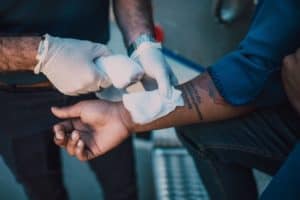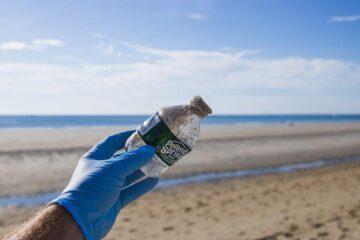What Should Be In My First Aid Kit?
Injuries and accidents can happen anywhere- at the workplace, at home, or while participating in outdoor activities like hiking or camping. Although we don’t plan for them, accidents do occur. So, you must be prepared for such emergencies. No matter where you adventure or work, it is crucial to have a well-stocked first aid kit so you can deal with minor injuries and accidents. But what items should you have in your first aid kit?
If you have ever built a first aid kit for your school project, then you understand all the usual items that are required to be inside it: an antiseptic, strips of adhesive bandages, scissors, and more. Your first-aid kit can, of course, be as elaborate or as simple as you like. This post will look at essential first aid kit items that doctors say should be included in your hiking or camping gear.
Top 14 Items You Should Have In Your First Aid Kit
The list of things you could include in your first aid kit is typically endless, so you need to concentrate on the basics and later build on that for your personal needs and lifestyle variations. Here are our top 14 must-have items that you should have in your first aid kit:
1. First Aid Handbook
The other things in the kit won’t be of great help if you don’t know how to properly use them. Read your manual carefully so that you can be prepared to deal with all types of emergencies.
2. Sterile Gloves
Gloves protect both the rescuer and the victim while treating wounds offering a germ-free barrier between the two. Make sure that you have two pairs of non-latex gloves if you or your friend are allergic to latex.
3. An Antiseptic
You can use an antiseptic to prevent infections caused by fungi or bacteria and clean wounds. It can be used to eliminate any debris and dirt after a minor injury. This could include your favorite antiseptic wipe, hydrogen peroxide, or a first aid spray. Alcohol shouldn’t be used as an antiseptic.
4. Adhesive Bandages
Adhesive bandages help to cover your wounds after it has been treated and cleaned. The adhesive bandage will prevent your shoes (or clothes) from rubbing against your wound while keeping it dry at the same time. Scrapes, burns, and cuts are some of the common injuries you may experience when exploring outdoors. To deal with such injuries, you should keep adhesive bandages of various sizes in your first aid kit.
5. Tweezers and Scissors
Getting a splinter in your skin is never pleasant. Not only is it uncomfortable, but it can cause an infection if it is left unattended for too long. Tweezers can assist you in eliminating stubborn splinters. Keeping them in your first aid kit implies that you can access them faster instead of attempting to search through your house to find them. You can also use the scissors to cut gauze or tape or remove clothing where necessary.
6. Pain Relievers
Ibuprofen, aspirin and acetaminophen can all in soothing minor pains and aches. Aspirin should not be given to anyone below 18 years because of the risk of Reye’s syndrome. Make sure you stock up on paracetamol if you have kids to help relieve pain.
7. Tape and Gauze
For scrapes and cuts, you can utilize gauge pads to apply pressure to minor wounds until bleeding subsides. When used together with tape, gauze can also act as a bandage to cover and safeguard wounds.
8. Instant Cold and Heat Packs
You can use an instant cold pack to help treat and soothe burns and other minor injuries, including sprains, strains, and insect stings. These instant cold packs can help ease pain in case you slip, trip, bump your head, and fall. The cold pack compresses can be used for headaches, burns, minor sprains, and nosebleeds.
9. Antibiotic Ointment
Antibiotic ointment is important for treating different injuries and can help to encourage speedy healing for wounded areas. While antibiotic ointment can assist prevent infections, we should only apply it to a wound after it has been properly cleaned with alcohol swabs.
10. 2 Triangular Bandages
To help keep your sprained joints immobile and ease swelling, your first aid kit should have at least two triangular elastic bandages. This kind of bandage comes with either a hook-and-loop or metal fastener and is flexible sufficient to be wrapped around your ankles, wrists, and knees.
11. Emergency Blanket
In the winter months, one of the last things you want is to be without heat. If you lose power, having an emergency blanket can help offer warmth. You may also consider keeping space blankets in your first aid kit. Such materials trap your body heat so that it remains adjacent to you and helps to keep you warm.
12. Thermometer
This is a great tool to measure and keep track of fevers. Keeping a thermometer in an easily accessible spot within your first aid kit can help to check your friend or family member for fever and know what steps you require to take next.
13. A pen and notepad
It’s a great idea to include this in your first aid kit, as it will remind you to write down details and symptoms of what caused it. This information can be crucial for paramedics or doctors to understand if the situation needs further help.
14. Prescription Medications
Remember to keep any prescribed drugs, including asthma inhalers, insulin, and allergy medications, which will be stored as directed. Keeping a stock of your regular medications can be helpful in case of an emergency, such as a hurricane, blizzard, or another disaster. You should also keep your dosing instructions in the first aid kit.
What should not be in your stocked first aid kit?
Your first aid kit should not contain any items that are expired or are no longer in a state to be used, e.g., they are no longer sterile or have been damp or soiled for whatever reason.
If your first aid kit contains sterile normal saline or sterile water and the seal has been broken, you should dispose of the water, and the containers should not be reused. You can add some other items for more advanced first aid kits like, tourniquets and suture kits.
How often should you replace the items of first aid kits?
Although there is no prescribed review timeline, many items in your first aid kit, especially the sterile ones, have their expiry dates marked. You should replace the contents of the first aid kit with the expiry dates given and dispose of them safely. In the case where sterile first aid items have no dates marked, we highly recommend that you check out with the manufacturers to know how long they can be stored. For non-sterile items without expiry dates, it is a matter of judging whether they are fit for the intended purpose.
What are the three types of first aid?
- Emergency first aid- This focuses on breathing, circulatory, airway, and prevention of life-threatening injuries.
- Standard first aid– This covers all the contents of emergency first aid as well as spine and head, and neck injuries and wound care.
- Child care first aid– This includes standard first aid content plus childhood safety and illnesses.
Do first aid kits expire?
There are items in your first aid kit that have expiration dates, and you should replace them once they reach the marked dates. For example, after adhesive bandages have expired, they may not stick to the skin. The same applies to the tape. Besides, expired bandages may no longer be sterile.
Why are first aid kits important?
First aid kits contain important supplies which can be utilized to treat minor injuries in case of emergencies or accidents. These are crucial pieces of equipment and should be accessible in all workplaces. These kits are generally suitable for treating injuries like scrapes, burns, and stings.
If you are headed outdoors, you must always carry a prepackaged first aid kit or create your own using the list of items discussed above. Knowing how to properly use the items in your kit is as crucial as having them, so consider reading the first aid kit handbook /manual to make the most out of your kit. A well-stocked first aid kit can assist you in responding to emergencies and common injuries that can occur while camping or hiking outdoors.



